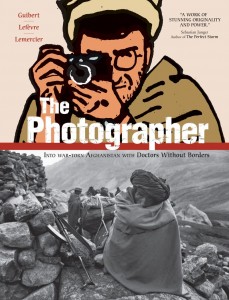
 ‘”The thing about a visual form like a graphic novel is that so much of what you need to describe is done through art. It’s the impact of the visual that conveys the story to the reader.” Terry Brooks, “A very Graphic Interview,” Publishers Weekly, 07/07/08.
‘”The thing about a visual form like a graphic novel is that so much of what you need to describe is done through art. It’s the impact of the visual that conveys the story to the reader.” Terry Brooks, “A very Graphic Interview,” Publishers Weekly, 07/07/08.
Those of us who did not grow up with comic books, may dismiss the burgeoning graphic novel form as strictly focused on fantasy and super-herosim. In fact, graphic novels can convey themes of adult proportions, creating emotional complexities and plot subtleties through “sequential images.” You can search “graphic novels” in the library catalog to discover resources on collecting, education, and the novels themselves, or use the Graphic Novels Core Collection: A Selection Guide to find recommended titles including reviews. The Libraries’ Jaffe Center for Book Arts Collection also has a selection of carefully chosen graphic novels.
Below, are titles from the circulating collection that will introduce you to a new aspect of this literary form.
Asterios Polyp
By David Mazzucchelli. Puffin Books, 2005
Call Number: PN6727.M2476 A77
Asterios Polyp, its arrogant, prickly protagonist, is an award-winning architect who’s never built an actual building, and a pedant in the midst of a spiritual crisis. After the structure of his own life falls apart, he runs away to try to rebuild it into something new.
Cairo: a graphic novel
Written by B. Willow Wilson; art by M.K. Perker; lettered by Travis Lanham, DC Comics, 2007
Call Number: PN6727.W535 C35
In bustling modern-day Cairo, the lives of a drug runner, a down-on-his-luck journalist, an American expatriate, a young activist, an Israeli soldier, and a genie are interwoven as they navigate the city’s streets and spiritual underworld to find a stolen hooka sought by a wrathful gangster-magician.
Frank Miller’s Sin City
By Frank Miller, Dark Horse Books, 2005
Call Number: Jupiter, PN6727.M55 S55
Criminals have always called the shots in Sin City, whether bootleggers, gamblers, or politicians. But ever since the first dame set up shop in Old Town, those side-streets have been run by the women who walk the night.
Good-bye
By Yoshihiro Tatsumi. Drawn & Quarterly Publications, 2008
Call Number: Jupiter Campus, PN6790.J34 T25
Drawn in 1971 and 1972, these stories expand the prolific artist’s vocabulary for characters contextualized by themes of depravity and disorientation in twentieth-century Japan.
Graphic novels core collection
H.W. Wilson
This selection guide highlights approximately 2,000 recommended graphic novel titles, with descriptive and evaluative annotations, plus cover art. The annotations also include review excerpts and awards the title has won.
Incognegro
Written by Mat Johnson; art by Warren Pleece; lettered by Clem Robins. Vertigo/DC Comics, 2008
Call Number: PN6727.J6467 I53
The early 20th Century: an era when lynchings were commonplace throughout the American South. To most of the press, this epidemic of racial murder wan’t even news. But a few courageous reporters from the North risked their lives to expose these atrocities.
Persepolis: [the story of a childhood]
By Marjane Satrapi. Pantheon Books, 2003
Call Number: PN6747.S245 P4713 2003
In powerful black-and-white comic strip images, Satrapi tells the story of her life in Tehran from ages six to fourteen, years that saw the overthrow of the Shah’s regime, the triumph of the Islamic Revolution, and the devastating effects of war with Iraq.
The Photographer
By Emmanuel Guibert, Didier Lefèvre, Frédéric Lemercier ; translated by Alexis Siegel, 2009
Call Number: PN6747.G85 P4913
In 1986, Afghanistan was torn apart by a war with the Soviet Union. This graphic novel/photo-journal is a record of one reporter’s arduous and dangerous journey through Afghanistan, accompanying the Doctors Without Borders.
Samurai champloo
By Masaru Gotsubo. Tokyopop, 2005
Call Number: PN6790.J3 G6
Three strangers–a hardworking waitress, an arrogant mercenary, and a mysterious samurai–form an uneasy alliance when they find themselves on the run from the law.
Wordless books: The original graphic novels
By David A. Beronä. New York, 2008
Call Number: NE1095 .B47
What it is
By Lynda Barry. Abrams, 2008
Call Number: NE1095 .B47
How do objects summon memories? What do real images feel like? For decades, these types of questions have permeated the pages of Lynda Barry’s compositions, with words attracting pictures and conjuring places through a pen that first and foremost keeps on moving.

